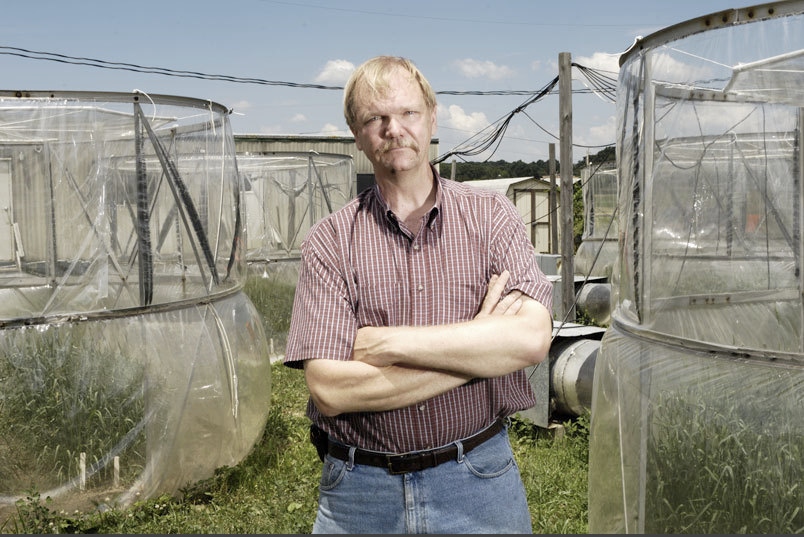September 27, 2018

The earth’s climate is changing, and — whether you agree with that statement or not — the chances are agricultural production is already being impacted in some parts of the United States, including those where rice is grown, a USDA scientist said.
Dr. Lewis H. Ziska isn’t a climate scientist, nor does he claim to be. But the plant physiologist who works with the USDA’s Agricultural Research Service in Beltsville, Md., says the impact of increased levels of carbon dioxide in the atmosphere can readily be observed.
“When it comes to looking at CO2, we’ve been monitoring carbon dioxide since the late 1950s,” says Ziska, who works with the USDA-ARS Adaptive Cropping Systems Laboratory in Beltsville. “When I was born it was about 315 parts per million, and today it’s about 410 parts per million. So it’s gone up by almost 30 percent in my lifetime.
“That increase is actually, in terms of a geological basis, the biggest, the highest concentration of CO2 we’ve seen in the last million years or so,” says Ziska, who was the presenter for a University of Arkansas Food and Agribusiness Webinar, “Climate Change, CO2 and Rice Production in the 21st Century: Now what?” (https://bit.ly/2PZFfmA)
Ziska, who was a project leader for global climate change at the International Rice Research Institute in the Philippines before joining USDA, said he wanted to “make sure everyone was on the same page” at the start of his presentation.
“When we look at atmospheric CO2, we recognize that carbon dioxide is a byproduct of burning of fossil fuels,” he noted. “Any carbon source, whether it’s methane or coal or gasoline, when you oxidize it; when you burn it; you’re producing carbon dioxide. About 90 percent of that comes from fossil fuels and cement; 10 percent from burning forest.
“About 50 percent of it stays in the air; about 25 percent gets reabsorbed by vegetation; and about 25 percent gets dissolved into the world’s oceans.”
How much higher?
How much higher can carbon dioxide concentrations go from the current level of 410 parts per million? If the world continues to burn fossil fuels at the current rate,
CO2 will be somewhere from 800 to 1,000 parts per million by the end of the current century.
Ziska said carbon dioxide and water vapor or humidity are the two main components of the atmosphere in global warming.
“What do we mean exactly when we say global warming?” he said. “The best way I can explain global warming is to turn to the guitar. We all know when I tune two strings of my guitar to the same frequency, and pluck one string, the string next to it will resonate and absorb some of the additional energy.
“This is what molecules do, as well. They don’t absorb, but water vapor and carbon dioxide absorb in the key of infrared. When heat hits these molecules they resonate, absorb some of the energy that would otherwise be lost. You know water absorbs heat, but so does carbon dioxide. That, in itself, is not a bad thing. If there was no water vapor and CO2 the average surface temperature of the earth would be minus 18 degrees C.”
With the current levels of carbon dioxide and water vapor the temperature is about 15 degrees C or 59 degrees F. “So it’s livable, and we call this the natural greenhouse effect.”
Misconception
One misconception that helps feed the controversy over climate change is the idea that temperatures will rise uniformly around the globe. They won’t because CO2 and water vapor do not occur in similar proportions everywhere.
“As an example, where the earth is warm and humid, where humidity or water vapor is the principal greenhouse gas, adding more CO2 will change things a little bit but not a lot,” he said. “That’s pretty much in the tropics. So, in the tropics, we’re not seeing a big increase in terms of temperature.
“Where the air is dry and can’t hold water vapor it is going to respond more strongly to the uniform increase in carbon dioxide,” he said. “The obvious places will be at the poles where the air is cold and dry. It doesn’t hold a lot of water vapor, and adding more CO2 is going to have a precipitous effect in terms of surface temperatures.”
Deserts are another example, because the air is hot and dry and will be proportionately more affected by the increase of CO2. “Also, as you go up in altitude, the air becomes drier. As you change seasons, the air becomes drier. Summers are going to be warmer and wetter, winters are likely to be warmer.
“And it’s the differential rate of warming where some areas like the poles are warming 5 or 6 degrees, and other areas are not changing much. But that differential area of warming will drive extreme weather events.”
Plants will be affected differently. “There will be less temperature increase where water vapor is high, but more precipitation,” he said. “That is, warm and wet is going to become warmer and wetter. Places with higher latitudes or altitudes are going to get greater temperature increases.”
Plants need light, water and nutrients. “Now suppose one of these resources were, in your lifetime, to go up by 25 or 30 percent. Would that have an impact in terms of plant biology? Of course it would. Would all plants respond the same way? No.”
Ziska displayed a slide with a photo of a school bus covered with kudzu. “We know from experiments that, in fact, kudzu responds well to CO2. But not all plants are beneficial to human society, and not all plants are going to respond the same way.”
Rice production
What about rice production? Researchers believe growers may see shifts in weather patterns rather than uniformly warmer temperatures.
“The average temperature is going to shift,” he said. “But everything shifts. It isn’t that you’re not going to get below average or cooler temperatures, they’re just not going to be as frequent. In addition, you’re going to get extreme temperatures.”
High nighttime temperatures have been shown to have a greater negative effect on rice yields than high daytime temperatures. Scientists expect the rise of CO2 to have a bigger effect on temperatures by trapping more heat at night.
The hypothesis is with a one-degree increase above that critical temperature of 24 degrees C, or about 75 degrees Fahrenheit, that’s going to lead to a 10 percent reduction of both grain yield and bio mass,” Ziska said. “Since 2000, there’s been an average of 20 days per season where the temperature is that high in Stuttgart, Ark.”
That has translated to a decline in rice production in one of the state’s leading rice counties. “I’m sure there are other aspects of this that we need to investigate further. But it’s really interesting. This is something that, if I were a grower, I would want to pay attention to.”
About the Author(s)
You May Also Like






